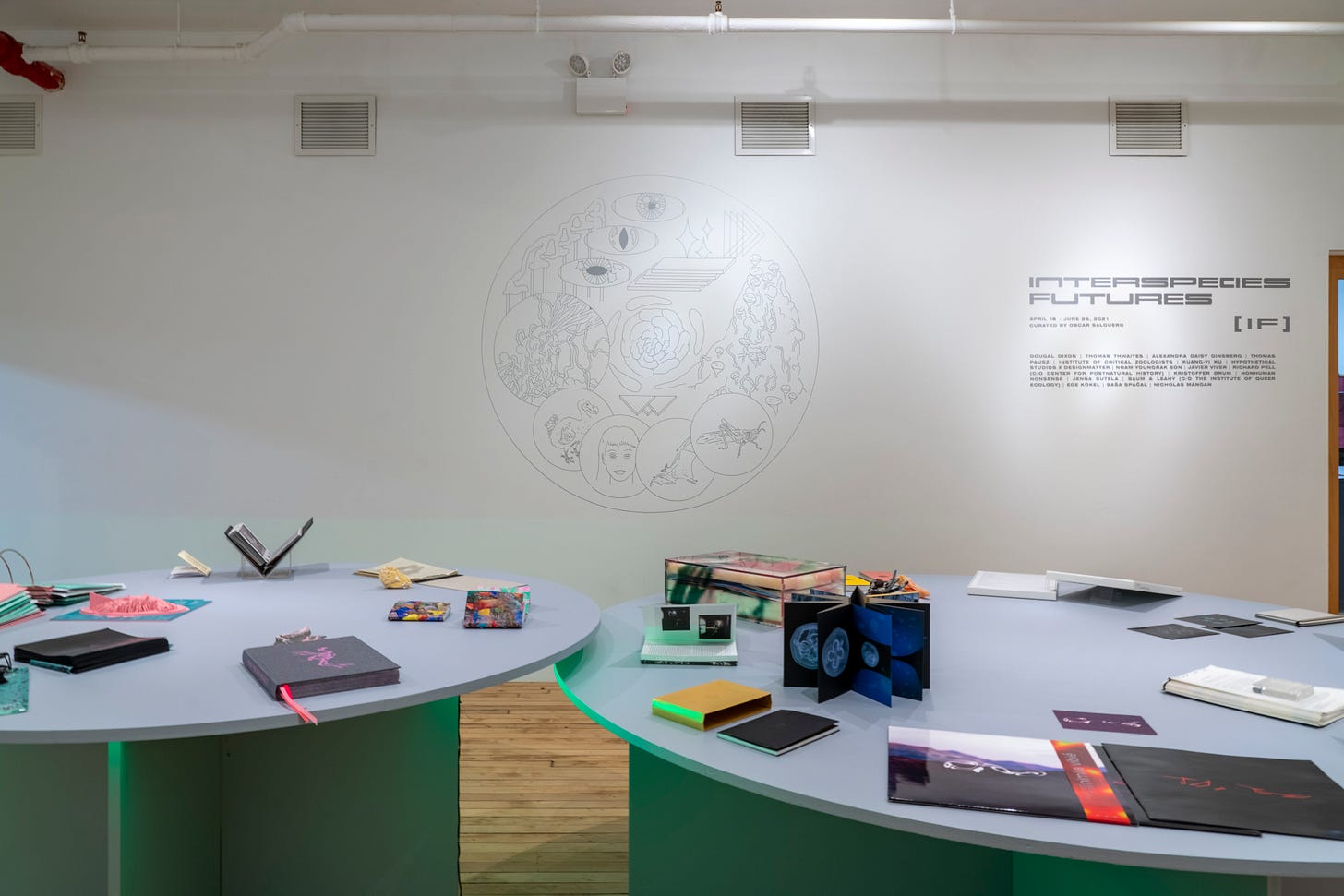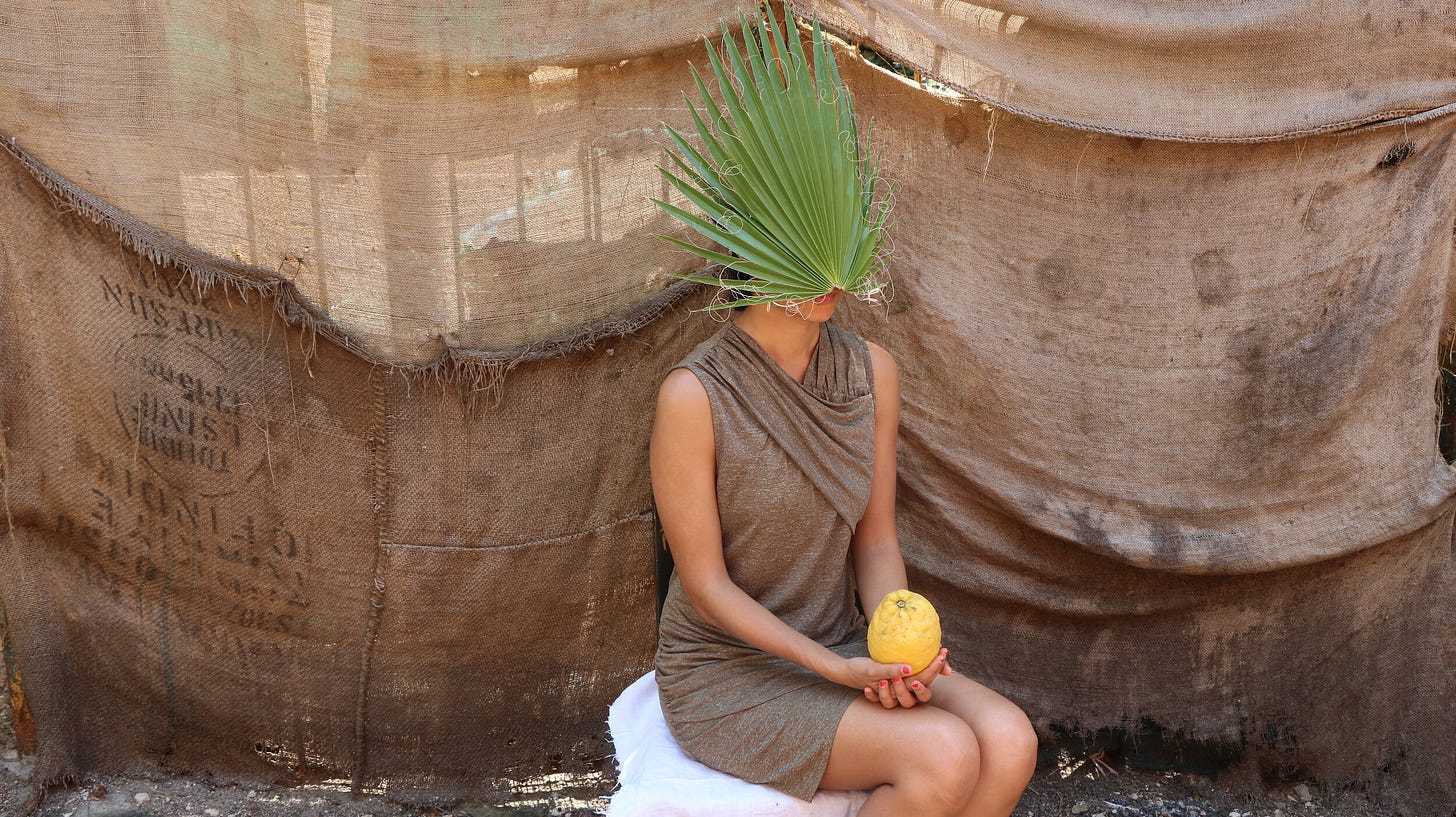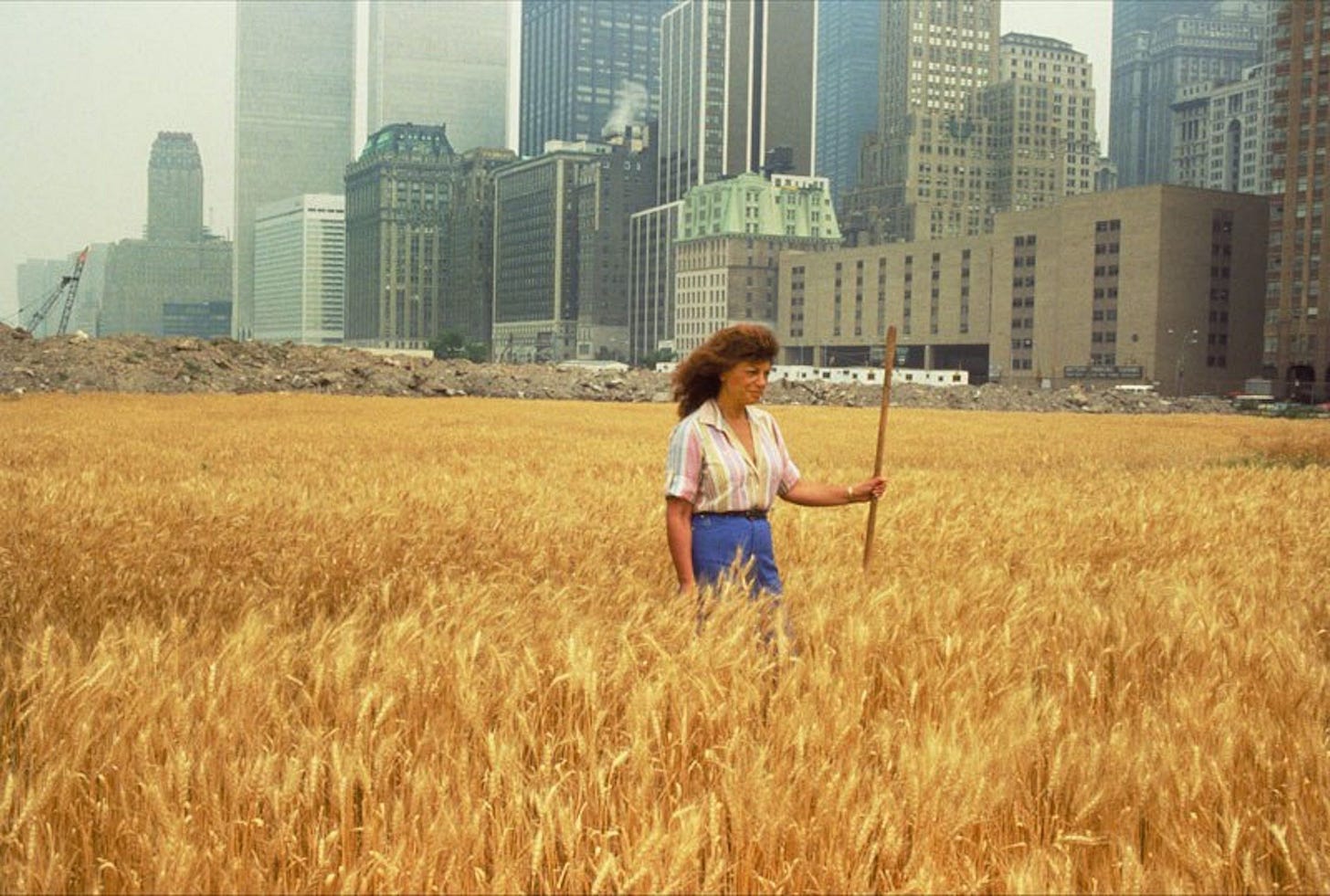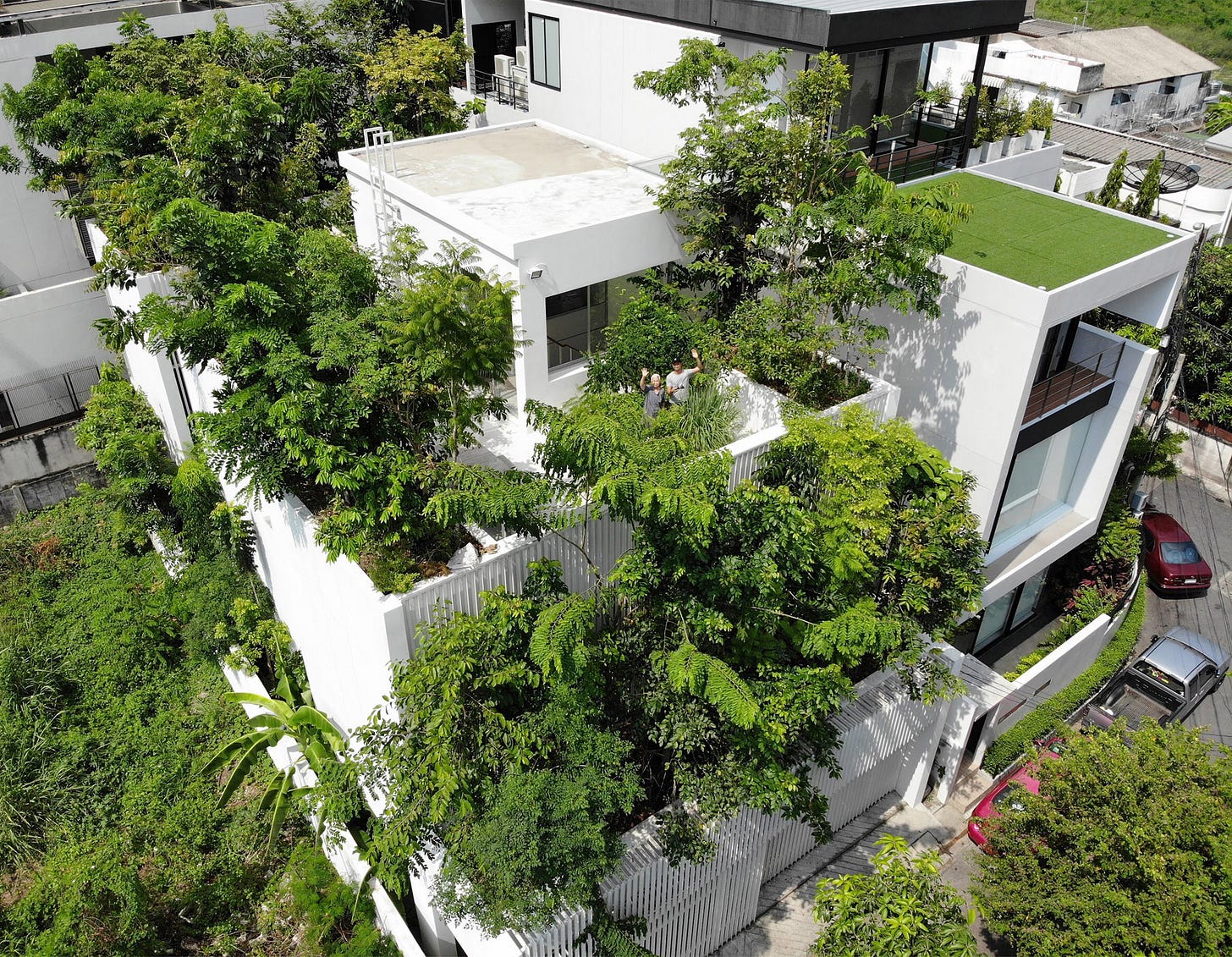032. Environmental Reliquary (II)
Our days are now spent accumulating glazes of sweat as we walk around, our nights falling sleep to the lulling roar of our fans and air conditioners only to wake up kissed by a mosquito bite (or two)
Hello friends,
Summer is slowly making its way across this hemisphere. Our days are now spent accumulating glazes of sweat as we walk around, our nights falling sleep to the lulling roar of our fans and air conditioners only to wake up kissed by a mosquito bite (or two). We’re all stepping outside with a new appreciation of our surroundings, especially after a long year of quarantine got us reacquainted with our local parks, got us driving to remote campsites and hiking trails, and taking notice of local flora and fauna on walks around the neighborhood. Here in New York, community gardens have started to reopen their gates again. There’s nothing I love more than catching a glimpse of their dedicated caretakers wheeling around carts packed to the brim with seedlings, soil, and tools into their peaceful kingdoms of raised beds and compost bins, just out of reach from the usual cacophony of sirens and car horns.
So, in this second part of this environmental newsletter, a blooming of ecological beauty from the sky down to the soil and seas, eternally interconnected.
TOUCH
Last week, my boyfriend and I travelled to Omaha, Nebraska for a wedding and, during some downtime before the ceremony, we decided to go to the Henry Doorly Zoo. I couldn’t remember the last time I went to a zoo, but we absolutely had to go see the Desert Dome, which is the world’s largest indoor desert housed inside the world’s largest geodesic dome. Yes, it was every bit as awesome as it looks. Full of animals undergoing research and conservation efforts contained within its artificial atmosphere, I loved wandering through its carved landscape, eventually descending down into dark underground rooms full of nocturnal critters, insects, and reptiles.
How might book-making help us understand our increasingly complex relationship to animals? The Interspecies Futures show at the Center For Book Arts is a bold, experimental look at how technology has shaped our connection to nonhuman creatures. A couple gems: a text that imagines synthetic animal parts as the solution to wildlife poaching and trading by Kuang Yi-Ku and Noam Youngrak Son’s piece that considers viruses through a book designed for nonhuman sensory perception. From CRISPR gene editing and bio art to handmade field guides and reckonings with COVID-19, each publication featured in this show pokes holes at our anthropocentric understanding of the world, and lab-grown, furry, scaly futures come wriggling out.
I’ve talked about my love of Emergence Magazine on here before, but I recently found myself turning to their print iteration during this especially chaotic time. I treated myself to their first volume last year and, in the frenzied rush of reading goals and squeezing chapters into any free minute I get, I find that this book invites me to slow down unlike anything else. It opens up a space for me to think deeply about the people, cultures, and environments I encounter in these stories. I leave each essay or poem with a newfound appreciation for the diverse beauty of our world, and for their authors who showcase their subjects with great respect and reverence for the many cultural and ecological topographies of the planet.
I still think about something a friend once told me, that poetry oftentimes feels closer to sculpture than any other form of writing. The Eco Language Reader has so far been the text that comes closest to capturing that sensation of the physical and written spilling into each other. Edited by Brenda Iijima, this is a collection of essays by some of the best known voices of environmental poetry today. These writers who seek to build worlds and make sense of environmental transformation (and disaster) through poetic forms, shaping our understanding of ecopoetics beyond just the lavishing beauty of the pastoral, towards an understanding how landscapes are constructed by culture through the lenses of gender, race, class, and geographical place-making.
LOOK
Multi-media artist, writer, and performer Himali Singh Soin builds her work directly from the topographies of earth and myth. Her video piece, as grand as what (pictured above), stages the fictional rituals of deities in the area surrounding Mt. Vesuvius, blurring the boundaries of creation and destruction. I’m also struck by her ongoing series, Static Range, which merges together sound, letter-writing, poetry, photography and collaboration to untangle the nuclear histories and cultural mutations at play across the snow-capped peaks of Nanda Devi in the Indian Himalayas. Soin’s ongoing fascination with ice has manifested into pieces centered around mythology and deep time, like her short film we are opposite like that and her audio exploration of the North Pole for BBC Radio 4. Even in places where no human life appears, Soin pulls something divinely beautiful from the land’s frozen ruins.
Land art’s tectonic movements of rock and soil has long been dominated by a canon of male artists, but Agnes Denes’s practice of tree-planting and mountain-making stands in sharp defiance of the movement’s tendency towards masculine ecological destruction and displacement. Denes’s site-specific, conceptual earthworks unite harmonious aesthetics with socio-political ideals. One of her most famous pieces, seen above, was a giant wheatfield over a Manhattan landfill in what is now Battery Park. She’s also responsible for the world’s first man-made virgin forest, Tree Mountain–A Living Time Capsule, whose growth will be protected by Finland’s government for the next 400 years. Among Denes’s many designs and plans, I am curious to see how her Forest For New York will sprout in Queens’s Edgemere Landfill. She writes about this ambitious project, “The importance of this project is not only to help with health conditions but to transform a treeless, barren landfill into a thriving forest. More than merely cleaning the air and ground water, a place of beauty will be created that people will be able to visit and take pleasure in, a destination to give them strength for the challenges of modern life.”
Dutch illustrator Maria Sibylla Merian is considered by many to be a pioneer in entomology, not only for her detailed illustrated scientific volumes but for her discoveries of new species and elements of insect throughout her career as a naturalist. When we think about studying the environment these days, images of scientists lugging cameras, looking through microscopes, and monitoring computers come to mind. Yet, artwork like Merian’s offered readers and researchers some of the most insightful images of tiny specimen at the time. Her little scenes of a fictive nature are a reminder that art is one of the most powerful tools we have to understand our world.
Textile artist Alexandra Kehayoglou is most known for her lush topographical rugs of winding rivers and rolling hills through hand-tufted techniques. Being within an environment is an inherently tactile experience, as you step over or reach out and touch the materials living and dying around you. Kehayoglou’s attention to these sensory details are unmatched and, even in photographic form, your eyes can’t help but sink into every little cut of rock or mound of earth. You can practically feel the smattering of grass under your fingertips or the drying gasp of desert dust around the corners of your mouth. Her practice is one of ceaseless adventure.
LISTEN
tree.fm is one of the coolest digital sound projects I’ve ever encountered. The concept is simple: like a radio station, listeners can tune into field recordings from forests around the world and escape into the gentle rustling of foliage, the small orchestras of bird calls and scuttling animals, and the soothing sounds of storms. Living in a city, I do my best to pay attention to the flora and fauna around me, but sometimes there’s nothing more I crave than getting lost in the isolated soundscape of a forest thrumming with a vibrancy of life.
Outside/In is a great podcast that pairs a love of the natural world with a dedication to environmental histories big and small. When we talk about nature, humanity always seems to exist outside or separate from it, but this show is a great reminder that these two realms are not as divided as we think. If you’re looking for a deep, scientific dive, I personally loved their episode on bogs, solar explosions, the critters growing in urban gutters, and traversing the perilous Darién Gap across Central and South America.
I first learned of Ayesha Tan Jones’s work in an episode of Serpentine Gallery’s Back to the Earth podcast series. I remember being struck by Jones’s interconnected practice, one that spans mediums and genres yet always tangled a the web of ecological systems and soil-based, spiritual knowledge-sharing. Among Jones’s many projects, like their apocalyptic opera Parasites of Pangu and their self-defense classes for Shadow Sistxrs Fight Club, is their musical alter ego, YaYa Bones. Last year, they released a haunting 4-track EP, EARTHEART, that weaves together spell-making and witchcraft with poetic calls for environmental action.
I couldn’t write about environmental sounds without including Mort Garson’s cult classic album, Plantasia. Released in 1976, Garson used synthesizers to create compositions meant for houseplant easy listening. This album is a whimsical imagining of plants’ tingly inner lives, like his symphony for spider plants or a playful concerto for pothos and philodendrons. My favorite peculiar fact about Plantasia is that this album was never meant to have a wide release, rather it came as a free gift every time someone purchased a Simmons mattress from Sears or a houseplant from the Los Angeles plant store, Mother Earth. I love thinking about what it must have been like to come home with the album in-hand, to living rooms filled to the brim with a jungle of greenery and Garson’s delicate, tinkling tunes dancing in the air like pollen.
LICK
As debates over geo-engineering and terrifying headlines about species extinction and rising temperatures cycle back around, Nausicaä of the Valley of the Wind has been on my mind again. As humanity struggles to survive in the shadow of a great toxic jungle, the leftovers of an apocalyptic war, this film presents a pathway to recovery paved with respect and under, rather than continued destruction, greed, and weaponization in the pursuit of dominance over the natural world.
“Sustainability” continues to dominate fashion, with more consumers questioning their spending habits and searching for new alternatives outside of fast fashion, wasteful overconsumption, and disposability. Imperfect Idealist continues to be one of the best educational resources out there for wading through the weeds of greenwashing. What I love about Lily’s TikTok is how she breaks down brands’ sustainability claims from ‘green’ certifications to the materials they use to how much they pay their workers, and she offers financially accessible alternatives. Her definition of environmentally-friendly, ethically-made sustainable fashion is one we should all use as we evaluate products being sold around us.
What does building with nature in mind look like? When we think of what goes into bringing an architectural design to life, we think of construction machinery uprooting its surrounding environment, the mess of debris, the cost of materials, the emissions of equipment. This Bangkok home designed by Shma Company is a reminder that architecture can give back just as much as it can take. The Forest House is made to hold 120 decorative and edible trees with a tiered, open design for maximum ventilation and a built-in drip irrigation system to keep all of is greenery thriving in limited square footage. Besides the obvious benefit of food and clean air from the trees’ natural filtration, I appreciate how this house is built to last, rather than a flashy spectacle of ‘green’ urban design. The selection of juvenile trees will have an easier time growing into their new home, and the variety of species creates a micro-ecosystem parallel to Thailand’s natural diversity.
EcoTheo Review continues to be one of the best out for contemporary environmental writing. Their thoughtfully-curated selection of poems, essays, reviews, and interviews are rich with appreciations of nature, and consider how our understanding of ecology taps into bigger conversations about spirituality and environmental justice. It’s definitely the kind of publication I hope to end up in someday, but for now I love seeing what each new issue has to offer. Some gems from their newest one: this gorgeous visual poem by Dayna Patterson and this leafy tale from Susan Noakes.
CLICK
The interconnectedness of forests, likened to a form of Internet, is nothing new, but recent studies of mycorrhizal networks (underground linkages of fungi that transmit messages and nutrients among organisms) have given those theories new complexity. Ferris Jabr’s story for The New York Times on the social lives of trees continues to be one of my favorite on this phenomenon. It’s such a gorgeous immersive piece, one that takes you deep into the woods where battles for survival, calls for help, and threats of deforestation permeate the communities growing above and below. I highly suggest pairing Jabr’s great reporting with The Daily’s audio story about the forest ecologist whose tireless curiosity brought the Wood Wide Web to our attention.
In 2001, botanist Sophie Leguil began to take notice of blooms poking out from sidewalk cracks and through the walls of city structures. This documentation of the biodiverse minutiae of urban ecology became More Than Weeds and it has blossomed into guided tours, ID guides, and grassroots organizing all centered around public education and preserving native flora. While many of these species fall victim to pesticides, paving, and weeding thanks to rigid urban landscaping, they are valuable contributors to local ecosystems, acting as pollinators and pollution- and flood-mitigators in areas lacking green spaces. Leguil’s tireless work in urban plant conservation has helped cut down the use of chemical pesticides across the UK and opened the door for research through More Than Weeds’s network of citizen-scientists.
Anjali Vaidya’s essay, “Native or Invasive” takes us to the Indian Institute of Science in Bangalore where, among the city’s traffic-clogged polluted streets, this campus’s manicured collection of exotic trees appears like a little oasis. This collection of foreign specimens is more than aesthetically-pleasing landscaping, it’s a scar of colonialism that continues to grow and spread beyond the institute’s walls. Vaidya’s piece reads like a walking botanical tour, and is a meditation on her Indian cultural identity in the face of Western, colonial influence. Through an analysis of Lantana involucrata, a common flower with origins in the Caribbean that has since adapted and hybridized in its new ecosystem, Vaidya wrestles with the ghosts of empire.
Caroline Crew’s poem, “A Sickening, Bucolia,” bites and thrashes under entanglements of bodies and ecological apocalypse. Crew reckons with a gendered history of environmental exploitation and commodification, moving between artificial, human-made environments and what few corners of wilderness remain. “These flower crowns are organic with next day shipping available and thus there is a sickness.” She writes, “The interstate ramp is burning and thus there is a sickness.” It’s a poem rife with profound reflections on one’s agency, on how we consume things and one another, what resistance and resilience it takes to begin healing.
Thanks for taking the time to read! Feel free to share this little project of mine with your friends, lovers, and enemies. If you like what I do, you can help feed my leopard gecko through Ko-Fi or check out my website. You can find a list of books by the people I mentioned on Bookshop (I get a small commission through this and any affiliate links in this letter).
Until next time,
Ellie













